Chapter 01 : Natural hazards
Introduction
In Standard Six, you learnt about the Concept of climate change, global warming and the relationship between human activities and global warming. Similarly, you learnt about the various hazards caused by global warming, their effects and the different measures that are used to deal with the hazards. In addition, you how to control environmental degradation, In this chapter, you will learn to identify natural hazards and how to control their effects, Also, you will learn about fire hazards caused by natural forces, their effects, fire prevention and principles Of firefighting and rescue. The competencies gained from this chapter will enable you to identify natural hazards and take appropriate measures to reduce their effects.
The concept of natural hazards
Natural hazards are catastrophic events caused by natural forces that Occur suddenly or gradually thus, causing disasters, These hazardous events may be regarded as disasters if their occurrence leads to serious damage and the affected community does not have adequate resources to avoid Of recover from the catastrophe _ Some Of these natural hazards include earthquakes, volcanic eruptions, landslides, tsunamis, fire outbreaks, floods and droughts. Although the floods, droughts and fire outbreaks are natural hazards, they may as well be caused by human activities,
Natural hazards may occur either suddenly or gradually. Some of the natural hazards that Occurs Suddenly include floods, earthquakes, volcanic eruptions, landslide, tsunami, and fire outbreaks. Drought is one of the natural hazards that occur gradually These hazardous events can occur anywhere depending on the nature of that particular hazard. 0th er hazards occur repeatedly in the same area. These hazards may cause disasters such as deaths Of people and animals, loss Of or damage to vegetation. property, infrastructure. and disease outbreaks. Some of these natural hazards and their effects are as follows:
An EarthquakeAn earthquake is a sudden vibration or shaking that occurs in the upper layer of the earth. This vibration is caused by natural forces from the waves passing within layers of rocks under the ground. When rocks under the earth's surface move towards each Other they Often cause tension and friction, This process eventually causes a rupture that releases a vibration energy. In turn, this energy causes sudden vibrations in the upper layer of the earth. This is what is called an earthquake. Earthquakes can also be caused by volcanic eruptions and human activities such as nuclear explosions and mining. Earthquake is measured by an instrument called seismometer. Normally, it is difficult to detect signs of prospective earthquakes. This is why they cause serious damage if they occur around settlements, The damage include, deaths and destruction of property
Effects of earthquakesEarthquakes have various effects on the environment. Although, they last for only a few seconds, earthquakes may cause devastating effects. The effects of earthquakes depend on the magnitude of the quake, strength of the buildings or any other infrastructure, and the geological nature of the area affected by the earthquake. The following are some of the effects of earthquakes:
(a)Destruction Of environment and settlements: When an earthquake occurs, it causes rocks to crack which may result in destruction of infrastructures such as roads, railways and sports grounds. Earthquakes may also cause collapse of buildings such as schools, hospitals and settlements For example, Kagera and Katavi Regions in Tanzania experienced earthquakes in 2016 and 2019, respectively. The earthquakes destroyed infrastructure including roads, school buildings, hospitals and settlements;
(b)Outbreak of diseases: Earthquakes can cause damage to sewage systems. The damaged sewage system may discharge waste water that contaminates clean water systems. When human beings use contaminated water for cooking, drinking, bathing and cleaning utensils, they are likely to be affected by waterborne diseases such as typhoid, cholera and diarrhoea. Likewise, earthquakes may cause introduction Of dust and toxic fumes into the atmosphere. This condition can lead to eye diseases and respiratory problems;
(c) ![]() Outbreak of fire: When earthquakes damage electrical infrastructure, cause volcanic eruption or rock collision, fire may erupt. When that happens, it becomes very difficult to control fire outbreak as fire fighters can hardly reach the affected areas due to the damage of infrastructure;
Outbreak of fire: When earthquakes damage electrical infrastructure, cause volcanic eruption or rock collision, fire may erupt. When that happens, it becomes very difficult to control fire outbreak as fire fighters can hardly reach the affected areas due to the damage of infrastructure;
(d)Occurrence Of Tsunami: Earthquakes can cause large waves in the ocean called tsunamis. These waves travel at high speed to the shores where they may Cause devastation to human beings, animals and property![]()
(e) Changes in the ocean depths: Earthquakes may cause the ocean floor to shake, which subsequently results into movement or rupturing of the oceanic floor rocks. This condition can lead to spread of volcanoes that eventually solidify and reduce the depth of the ocean. In addition, an earthquake can cause bed-rocks along the ocean floor to experience tensional forces, develop faults and sink further into the crust ThiS iS likely to increase the depth of the ocean in the affected area: and
(f) Death of living things: Earthquakes have often caused deaths to humans and other living th'ngs. When an earthquake occurs, it can destroy buildings and damage infrastructure. When debris falls on people or animals it can cause death. Figure 1 shows some of the effects of earthquake on infrastructure.
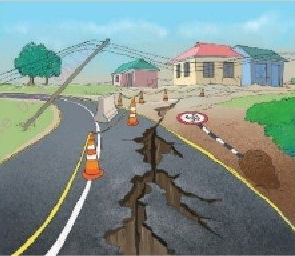 | 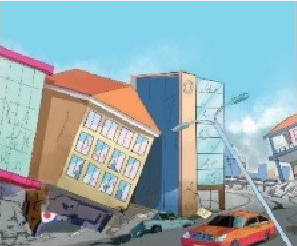 |
| Figure 1 Some Of the effects Of an earthquake | |
Precautions to be taken to reduce the effects Of an earthquake
It is important to take various precautions to deal with the effects of earthquake. One of the precautions is to provide education on how to prevent or reduce the impact of an earthquake when it occurs. This education should reach people of all ages; children, youths and the elderly, as well as people with special needs. This education should also take into account the source, highrisk areas with a history of frequent earthquakes, effects of earthquakes and ways to deal with them. Earthquake monitoring centres should use the media and various other stakeholders to educate the community on the effects Of earthquakes, and measures to reduce such effects, Citizens should be educated on the importance of building houses that can withstand earthquakes. Also, the land use planning department should conduct land use assessment before allocating land to citizens for settlement. In addition, if an earthquake occurs, you are advised to stay away from tall buildings, trees, electrical cables and poles, beaches and along major river banks. If you are indoors, go under a table or bed and cover your head and body with heavy clothing to protect yourself from heavy and sharp objects such as glasses. When the earthquake stops, cry out for helpv It is also safe to lie down several metres away from tall buildings or run towards open spaces such as playing grounds and farms,
| Exercise Answer the following questions: 1. List four effects of an earthquake, 2. Briefly explain why earthquake is a natural hazard. |
Temperature and pressure of the inner part of the earth is extremely high. This extremely high temperature causes melting of rocks surrounding it and turns them i nto a form Of very hot liquid called magma -As pressure increases, magma is forced into the earth's crust through cracks and fissures all the way to the earth'S Surface. When magma reaches the earth's Surface, it is called lava. Magma can also solidify inside the earth's crust.
Volcanic eruption is a process that involves magma getting out of the earth's crust. Volcanoes can eject out Of the earth'S surface violently or quietly. The nature of eruption depends on the amount of heat and pressure of the rocks in the earth's interior. Magma may be ejected to the earth's surfacer spill and flow, then solidify as shown in Figure 2. Volcanic eruption may also emit volcanic ashes that spread into the atmosphere- These ashes contain gases, such as sulphur dioxide, that are dangerous to living organisms. When magma erupts outside the earth's surface and loses gas, it is called lava. Lava may spread in a small or large area and then cools and solidifies. The cooled and solidified lava may form a volcanic mountain or lava plateau-
Volcanic mountains are also found in Tanzania. Some of these mountains have regular volcanic eruptions and are, thus, called active volcanoes. Mount Oldonyo Lengai in Arusha is a good example of active volcanoes. Other volcanic mountains are those that were formed by volcanic eruptions in the past, however, they still indicate signs of eruption the future. These mountains are called dormant volcanoes. Mount Kilimanjaro in Kilimanjaro Region and Mount Merv in Arusha Region are a good example Of dormant volcanoes. Furthermore, there are volcanic mountains called extinct volcanoes. These mountains have no indications Of erupting anymore although they did erupt many years ago. An example Of Such mountains is Mount Rungwe in Mbeya Region.
 |
| Figure 2: A volcanic eruption |
Effects of a volcanic eruption
When a volcano erupts it causes various effects on living things and the environment in general. Some of these effects include:
(a)Loss of biodiversity: When a volcano erupts, it releases lava that covers the earth's surface. Hot lava can kill living organisms such as animals, humans, plants and micro-organisms that are important for the ecosystem;
(b)Health related problems in the respiratory system, eyes and skin: When a volcano erupts, it emits heavy smoke, dust, and ashes that can cause health problems to living organisms, especially animals and humans. For example, as toxic ashes contact the skin, they can cause the skin to itch and get damagedv When heavy smoke with carbon dioxide spreads and is inhaled by living things, it can affect the respiratory system and even cause death;
(c)Destruction of property such as infrastructure and settlements: When a volcanic eruption occurs, it can destroy infrastructure such as roads,
(d)Pollution of water sources: Volcanoes can flow into water sources and distribute toxic chemicals that cause diseases and death to living things such as people, animals, plants and insects. In addition, volcanoes can block water sources leading to water shortages;
(e) Earthquakes and landslides: Volcanoes are accompanied by shaking of land that can cause landslides and earthquakes;
(f)Fire hazards: When lava spreads over dry vegetation, it can cause fire outbreak that could burn forests and settlements, as shown in Figures
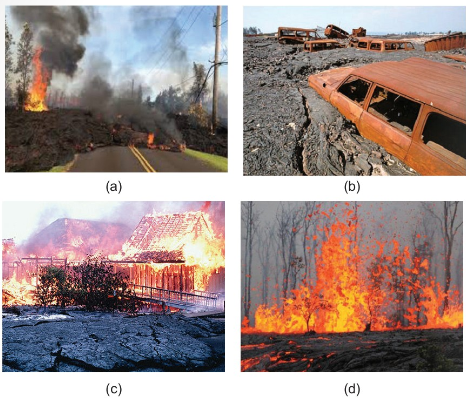 |
| Fig. 3 Effects Of Volcanic Eruption |
(g)Impact on climate: Volcanic ashes and sulphur dioxide that come from the eruption may reduce global temperature by reflecting the incoming solar radiation; but on the other hand, volcanoes can also cause global warming because they block the outgoing so ar radiation; and
(h) Clouds formed by volcanic ashes and dust are dangerous to air transport since they can damage aircraft engines.
Despite the fact that volcanic eruptions have many effects, they also have benefits such as producing fertile soil as well as ejecting minerals like gold and diamonds from the ground. Also. volcanic eruptions can cause occurrence Of springs in the land and islands in oceans.
| Exercise 2 Answer the following questions: Study Figure 3, and then answer the following questions: (a)What do you see in the pictures shown in Figure 3(a-d) (b)What precautions do you think the affected community could take to avoid the effects Of a volcanic eruption? (c)What kind of support is needed to help victims of the incident shown in Figure 3(C)? |
A volcanic eruption is one of the natural hazards that require care and preparedness before they occur. The government, in Collaboration with other stakeholders, should educate the public about the effects of volcanic eruptions. Citizens Should be educated about the consequences Of establishing their settlements in volcano prone areas. It is recommended that a person should build or establish settlements at least 50 kilometres from volcanic sources. In addition, the responsible authorities should provide early warning of any indication Of volcanic eruption before it occurs,
If a volcanic eruption occurs in the area where you live, it is advised that you run far from the volcanic source. It is important to wear a face mask (filter) to avoid inhaling toxic air from heavy volcanic smoke. As you walk
towards a safe area, avoid stepping on puddles or streams flowing from the mountain because you may tread on molten materials or hot water flowing from erupted volcanic mountain. If at the time Of volcanic eruption you are inside the house, then remain there until the rescue team arrives at the scene for evacuation.
LandslideLandslide is a rapid movement of a large mass of rocks or soil materials down slope due to gravity The steeper the slope the faster the movement and the gentle slope the slower the movement. Figure 4 shows an example of landslide.
 |
| Figure 4: Landslide |
Landslide is caused by various factors, such as volcanic eruptions, earthquakes, heavy rains, and floods. Volcanic eruptions cause shaking and collapsing Of the upper layer Of the earth's crust, This greatly leads to landslide as shaken soil materials become weaker because of several cracks. In addition, when an earthquake occurs, it weakens the bonds between soil and rocks, The ground becomes weak, so it is easy to collapse, Flooding also causes landslide as water table rises due to heavy rainfall or melting of ice. When the ground absorbs more water, it increases weight of the soil and decreases its adhesion. Consequently, the soil fails to stick together, which causes landslide. In Tanzania, for the last time the major events of landslide occurred in Same District in Kilimanjaro Region, and Kilosa District in Morogoro Region in 2014.
Effects Of landslidesWhen landslide occurs it can cause the following effects:
(a)Damage to infrastructure, properties and settlements: Landslide can destroy and block roads (as shown in Figures 4 and 5), It can also destroy railways, bridges, electric and telephone poles, oil pipelines and drainage structures. This condition may suspend productive activities for a period of time. In addition, when landslide occurs, it can destroy properties and settlements; thus leading into poverty;
(b)Damage to plants and deaths of animals: When landslide occurs. debris could cover animals and plants in the lowlands _ This can lead to animal deaths and damage the vegetation of the particular area; and
(c)Removal of the top fertile soil layers Landslide may cause the removal Of top fertile soil layers. The affected areas become unproductive and thus affect vegetation and agricultural activities. This condition can lead to lack Of adequate food in a particular area.
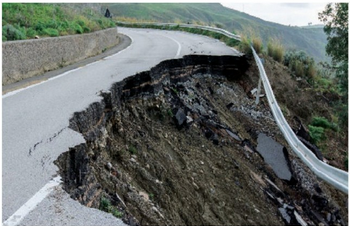 |
| Road damaged By Land Slide |
Precautions when dealing with the effects of landslide![]()
![]()
It is important to take various precautions in order to minimize and deal with the effects Of landslide. This can be done by planting trees and other plants in open and steep slopes as well as preventing illegal logging and burning of forests. Citizens should avoid construction activities on steep slopes and in valleys. This is because, by doing so, they increase chances of landslide in such areas. In addition, the responsible authorities should provide education about the possible effects of landslide and vulnerable areas. Also, the government should encourage citizens to be vigilant of weather forecast programmes via radio and television and take appropriate measures to avoid possible effects of landslide. Citizens should adhere to the principles of sustainable land use, especially in areas with steep slopes. Every citizen Should seek professional advice if they wish to establish settlement and engage in human activities such as mining and agricultural activities on steep slopes. Also, it is recommended to restore forest on surface-mined land by planting treas immediately after mines are closed to minimize chances of landslide-
Once landslide has occurred, you are advised to clear water systems blocked by debris such as mud and other solid waste. This could be done by cleaning the affected area to restore it to its original condition. Remove the mud and soil to restore the original land and the damaged settlements,
| Exercise 3 Answer the following questions: 1 . Briefly explain the effects caused by landslide in your area. 2.Which measures should be taken to avoid landslide? 3.HOW do floods, earthquakes, volcanic eruptions contribute to: landslides? 4.Briefly describe indicators that will show you that landslide is likely to" 5.Explain the how burning of forests contribute to landslide. |
Tsunami
Tsunami is a Japanese word meaning "harbour wave"'. Tsunami refers to huge ocean waves caused by earthquakes below the ocean floor or other natural forces such as volcanic eruptions or meteors falling in the ocean. Tsunami iS also caused by the displacement Of rocks iri the ocean floor. Nuclear bombs testing may also cause tsunamis.
An earthquake or other earth movements cause huge ocean waves which move and spread very fast. When these vibrations occur, they release energy in the ocean floor that causes large waves on the surface of the ocean, The waves begin to travel and increase in strength as they approach the shores. Tsunami waves are powerful and capable of travelling at a speed Of 10 to 800 kilometres per hour, and can last for an average Of one hour. These waves can reach a height of 10 to 30 metres. The Pacific Ocean in Indonesia and Japan experience frequent tsunamis. The occurrence Of major earthquakes beneath the Pacific Ocean is a major source of tsunamis in the region. Figure 6 shows the appearance of tsunami waves.
 |
| Figure 6; A tsunami rave |
Effects of tsunami
(a) Deaths Of people in the coastal areas; Tsunami waves significantly affect coastal areas. For example the largest tsunami in historical records occurred in the Indian Ocean, east Asia, on 25th December 2004, The incident affected several countries such as Indonesia, Singapore, Malaysia and India, This tsunami is believed to have caused more than 230 000 deaths in 14 countries. The effects were also felt in East African countries whereby 11 people in Tanzania and 1 person in Kenya lost their lives while swimming in the Indian Ocean;
(b)Destruction of settlements and infrastructure: Tsunami waves hit beaches and destroy infrastructure, as shown in Figure 7, The most affected properties include residences, hotels and restaurants, tourism centres, and different recreational areas, Also, tsunami destroys transport networks such as roads, railways, ports and airports as well as power houses;
(c) Flooding and pollution Of water sources: This condition is caused by large waves Of tsunami that move towards coastal areas and cause floods. Also, stagnant water in settlement areas may cause swamps that become breeding sites of insects. This situation causes spread of various diseases such as malaria, typhoid, Cholera and diarrhea;
(d)Destruction Of the habitats Of living organisms: When a tsunami hits fish-breeding areas such as coral reefs, they destroy and affect their existence. This causes fish and other marine organisms to die; and
(e) Damaging natural vegetation: Tsunami waves can erode trees and other vegetation. This leads to disappearance of natural vegetation eventually destroying the ecosystem Of the affected area which is habitat to various animals.
 |
| Figure 7: Effects of a tsunami on settlements along coastal areas |
Precautions to be taken to reduce the effects Of tsunamis
Tsunami does not occur frequently; nevertheless, it causes serious damages when it occurs. There are some precautions that one must take in order to minimise the impacts of tsunami. One of these precautions is to control enrichment and testing of nuclear bombs and explosives in the ocean, This will help reduce the frequency of earthquakes caused by human activities.
Avoid building or living along coastal areas. If construction takes place along coastal areas, it should follow professional advice about recommended distances from the ocean. The respective authority should give early warnings once signs of tsunami, such as earthquakes and tidal abnormalities, occur. This should go together with educating the public on the effects of tsunami and how to protect themselves. In addition, if tsunami occurs in your area, you are advised to move to high ground areas. By doing so, you would be in a safe area where a rescue team can reach for evacuation. It is also important to avoid swimming in the water streams that lead to the ocean because they may have strong waves which can carry you away.| Exercise 4 Answer the following questions: 1 . What is tsunami? 2.Explain causes of tsunami. 3.Explain why coastal areas of the Pacific Ocean are frequently affected' by tsunami, |
Fire hazards
Fire Is a combustion that produces heat and light. Fire is described as resulting from a chemical reaction between a combustible substance, oxygen and heat. Fire hazards are materials, substances or actions that increase the likelihood of fire outbreak. Fire hazards can be natural or caused by human activities. Natural fire hazards often occur in dense forests, for example, in the Amazon rain forest in Brazil and in the forests of the East and Northeast of Victoria Province in Australia. These hazards occur mainly during dry seasons. Among the sources of natural fires are volcanic eruptions and lightning. These are the most common sources of natural fires in dense forest areas. Another source of natural fire is the intense heat from the atmosphere that helps fire to burn more easily. Lightning and extreme heat causes fires that burn wood dust, dry leaves. and grass. All these nature induced fire usually spreads and burns a large area Of the forest,
Apart from natural sources, fire hazards are also caused by human activities, such as illegal burning of forests, honey harvesting, hunting, smoking, and the misuse Of gas energy, Oil and electricity. Fire caused by human activities often occurs in farms, forests, schools and residential and commercial areas. An example Of this type offire hazard is the one that occurred in 2017 and destroyed the SIDO market in Mbeya Region. It caused a significant loss of life and damage to property and commercial buildings, as shown in Figure 8 Another fire disaster caused by human activities was that which happened in Morogoro Region in 2019 where a fuel tanker overturned and spilled the fuel. As people were fetching the fueli someone else was trying to vandalise the tanker's battery The battery sparked and accidentally ignited fire on fuel. Suddenly, the whole tanker exploded along with all fuel being fetch, In that incident more than 100 people died, property was damaged, and the environment was polluted, as shown in Figure Another example is the fire that burnt Mihayo Secondary School in Tabora Region in 2018
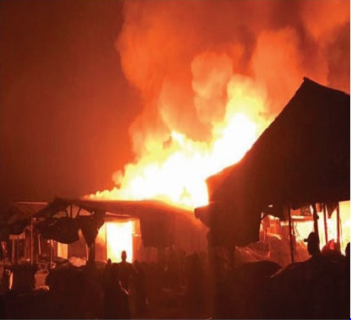 | 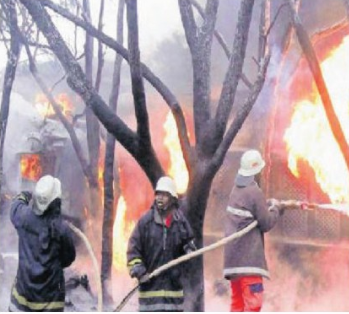 |
| (a) SIDO market buildings on fire in mbeya 2018 | (b) Firefighting operation at msavu morogoro in 2019 |
Effects Of fire hazards
Fire is among the most dangerous incidents in the society. The following are the effects Of fire hazards to society,
(a)It causes death and temporary or permanent disabilities to humans and other creatures. For example, fire that occurred in Morogoro in 2019 resulted in the loss of more than 100 people:
(b)Fire destroys property and infrastructure such as electric poles, oil and gas reserves. For example, fire Outbreak that happened in Morogoro in 2019 destroyed property such as motorbikes. bicycles and cars;
(c)The top layer of soil loses its ability to absorb and retain water for a long time. Fire causes the soil to become dry and develops cracks, thus failing to store water. The ground loses its cohesiveness and thus triggers landslide and floods;
(d)Increase Of carbon dioxide in the atmosphere: When forests burni they emit carbon dioxide that contributes significantly to the increase of atmospheric greenhouse gases that cause climate change;
(e) Destruction of wildlife and biodiversity: Wildfires cause extinction of some species and destroy wildlife habitats. For example, frequent fires in Mount Kilimanjaro National Park and Other wildlife conservation areas destroy animal habitats and cause deaths to wildlife:
(f)Fire causes suspension of social services such as schools, airports, and hospitals thus affecting the Whole community: and
(g)Fire causes unemployment if the workplace is completely bumed down, For example, when the Mwanjelwa and SIDO markets in Mbeya Region as well as the Samunge market in Arusha Region were burnt, many people lost their businesses and jobs.
Principles of firefighting and rescue operationsAccording to the Fire and Rescue Force Act No. 14 of 2007, the Fire and Rescue Force is responsible for extinguishing fires and saving lives and property, as well as dealing with any non-criminal emergencies. Regulations on firefighting and rescue services were formulated to support the rescue team and the rescued. For a successful rescue, the Fire and Rescue Force should cooperate with the community. The following are the principles to be followed in order to save lives and property during a fire outbreak:
(a)Ring bells, push fire alarms or scream loudly for help from other users of the building;
(b)Get out and call the Fire and Rescue Force's emergency number for further assistance. The emergency number for Tanzania is 114;
(c)you can use the available fire extinguishers to start extinguishing the fire as long as they are appropriate for use for the particular type of the fire source;
(d)Note thät, it iS important to switch Off electfiCity before starting extinguishing fire whose source is electricity. If it is not possible to switch Off the main switch, then use dry sand, a carbon dioxide or dry powder fire extinguisher;
(e) People who are not involved in firefighting are advised to run to a special open place so that it becomes easier for the rescue team to know their number and where they are placed for evacuation;
(f) When extinguishing fire, make sure the rear door is kept open so that if you fail to extinguish the fire you can easily escape;
(g) Once smoke increases, try to crawl while facing downwards to prevent poisonous fumes from getting into your nostrils; and if possible, put on a face filter mask,
(h) It is not recommended to go back to the burning building if the Situation is still unsafe;
(i) If attempts to get out are completely impossible, close the door and seal the bottom of the door with a damp cloth; and
(j) Stand near the window arid wrap a white Cloth to indicate your presence and ask or cry out for help.
| Exercise 6 Answer the following questions: 1 Explain why you should leave the rear door open during firefighting 2. List four principles to consider when extinguishing fire. 3. Why do you think we are advised to turn off the main electrical switch before extinguishing fire that is caused by electricity? |
How to get involved in preventing fire hazards
In order to respond effectively to fire hazards, various methods can be used depending on the location and source Of fire. You are advised to adhere to environmental regulations and precautions set to avoid causing a fire. Those precautions include avoid •ng smoking in high-risk areas such as petroleum stations, food warehouses, transportation facilities, and in large forests. Cigarette filters can also cause a fire if they are not properly extinguished and thrown in special containers.
In this regard we are therefore advised to:
(a)avoid all electrical and gas equipment which are not properly Checked before use.
(b)avoid using electronic devices of poor quality.
(c)ensure all repairs and check-ups should be done by trained and professional experts.
(d)use only the approved electronic devices,
(e)ensure that electronic devices such as iron. gas cylinder. electric cables, cell phones, radios, televisions and refrigerators are in good conditions before using them.
(f)inspect regularly the electrical wiring system of the buildings.
Furthermore, it is also advised to take precautions with the uses Of candles, battery, and charcoal stoves. We should have protective equipment against lightning, and we should have fire extinguishers and fire alarms. To prevent fire outbreak, farmers are advised not to start fires on their farms and dry grasses when winds are strong.![]()
![]()
Incineration of waste is also a source of fire. It is recommended that waste should be burnt in designated areas. away from flammable materials such as gas, oil, crop pulp and wood dusts. Welding should be done away from flammable materials such as paper. oil, wood and clothes. Similarly, before making charcoal there should be an approval from relevant authorities, as well as provision of adequate education on how to use charcoal burning technology Citizens Should be informed Of the importance Of extinguishing fire after collecting charcoal or cooking. Charcoal fires are slowly extinguished; SO it is important to extinguish the remains.
The above recommendations should also be observed in schools, Control the over use of candles and electrical equipment in dormitories or classrooms. Heaters or illegal wiring should be discouraged-
Vocabulary
- Biodiversity : variety of living species on earth, including plants, animals, bacteria and fungi
- Ecosystem : interaction of the organisms in their physical environment
- Energy : A source of power which generates heat
- Lava : molten materials on the earth's surface after a volcanic eruption
- Magma : heavy molten materials resulting from melting of rocks due to extreme heat at the inner part of the earth
- Tensional forces : forces that operate in different directions
- Volcanic ashes : hot ashes resulting from volcanic eruption
- Vigilant : keeping careful watch for possible danger or difficulties
- Rock : solid organic material of the earth's crust
| Exercise 7 Answer the following questions: A: Choose the letter of the most correct answer and write it in the box provided. 1.The following set of factors contributes to the occurrence of a volcanic eruption:
2. One of the following methods is not suitable to prevent fire outbreaks
3. A movement of rocks or soil materials following a steep slope is called...
4. The following factors may cause tsunami except
5. One of the following is a natural cause of wildfires
B: Write TRUE for a correct statement and FALSE for an incorrect statement in the space provided. 6. A volcanic eruption causes the formation of fertile soil_____________ 7.Landslide can be prevented by tree planting. _____________ 8. Oxygen is a natural air that, in its absence, fire cannot bum,. _____________ 9. Charcoal burning is the only source of fire in the forest. _____________ 10. Increased volume of groundwater due to heavy rainfall or 7 melting ice contributes to flooding. ___________ C: Write the correct answer in the spaces provided. 12. A sudden collapse of rocks or soil following a steep slope with the influence of gravitational force is called 13.Name three volcanic mountains found in Tanzania 14. List five possible effects of wildfires D: Answer the following questions 15. Name one natural hazard that you have heard of or witnessed Give your answers basing on the following:
16. Briefly explain the difference between natural and human induced hazards. 17. What do you think are the precautions to take in case of a tsunami in Tanzania? |
E. Match the items in Column A with their responses in Column B by writing the letter of the correct answer in the space provided.
| Column A | Column B |
| 18. Tsunami 19. Ring the bell or alarm 20. Oldonyu Lengal 21. Lightning and extreme heat 22. Earthquake and volcanic eruption 23. Effects of fire hazard 24. Magma |
|
www.learninghubtz.co.tz
Hub App
 For Call,Sms&WhatsApp: 255769929722 / 255754805256
For Call,Sms&WhatsApp: 255769929722 / 255754805256
 For Call,Sms&WhatsApp: 255769929722 / 255754805256
For Call,Sms&WhatsApp: 255769929722 / 255754805256
WHATSAPP US NOW FOR ANY QUERY
App Ya Learning Hub Tanzania






